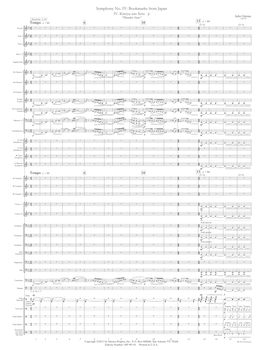Instrumentation
1 - Piccolo
4 - Flute 1
4 - Flute 2
1 - Oboe 1
1 - Oboe 2
1 - English Horn
4 - B♭ Clarinet 1
4 - B♭ Clarinet 2
4 - B♭ Clarinet 3
2 - B♭ Bass Clarinet
1 - B♭ Contrabass Clarinet
1 - E♭ Contra Alto Clarinet
1 - Bassoon 1
1 - Bassoon 2
1 - Contrabassoon
2 - E♭ Alto Saxophone 1
2 - E♭ Alto Saxophone 2
2 - B♭ Tenor Saxophone
1 - E♭ Baritone Saxophone
3 - B♭ Trumpet 1
3 - B♭ Trumpet 2
3 - B♭ Trumpet 3
2 - F Horn 1& 3
2 - F Horn 2 & 4
2 - Trombone 1
2 - Trombone 2
2 - Trombone 3
2 - Bass Trombone
2 - Euphonium B. C.
2 - Euphonium T. C.
4 - Tuba
1 - Contrabass
1 - Timpani
2 - Orchestra Bells, Chimes
1 - Xylophone
1 - Marimba
2 - Taiko Drums 1 & 2
5 - Percussion (Gong, Tam-tam,
Tom-toms, Tenor Drum, Snare
Drum, Bass Drum)
Symphony No. IV: Bookmarks from Japan
IV. Kinryu-zan Sensoji - “Thunder Gate”
Grade 5
for concert band
by Julie Giroux
The name of the print on the bookmark says “Kaminari-mon Gate of Asakusa Kannon Temple” but the true name of the print is “Kinryuzan Temple in Asakusa” by the artist Hiroshige Ando. Hiroshige died before before the entire collection was completed. Hiroshige II finished it. The first prints were published in order between 1856 and 1859.
PROGRAM NOTES
Originally built in 941 AD, Kaminarimon is the outer gate leading to the Senso-ji Temple which was constructed around 628 AD near Kamagata and later relocated to its present location in Asakusa, Tokyo, Japan in 1635. This large gate features four statues. The Shinto gods Fujin and Raijin are located on the front of the gate and the Buddhist god Tenryu and goddess Kinryust and on the reverse side. Fujin, displayed on the front east side of the gate, is the god of wind and Raijin, on the west side, is the god of thunder, giving the gate its nickname of “Thunder Gate.”
Displayed in the middle of the gate is a giant red chochin (lantern) which weighs approximately 1,500 pounds. Despite its huge size, it is very fragile. The front of the lantern bears the painting of the gate’s name Kaminarimon, and the painting on the back reads Furaijinmon, the official name of the gate. The bottom or base of the chochin displays a beautiful wooden carving of a dragon. Over the centuries the gate has been destroyed and rebuilt many times. The current gate dates to 1960 and the new lantern was donated in 2003.
As a tourist, you cannot get close to the statues as they are protected by fences and wire and you certainly cannot touch them. Despite all of that, the magnificence of the gate still shines through, bearing testament to centuries of humans that have passed through its structure and those who will in the centuries yet to come.
MP 99110
Duration: 3:14
Score & Parts: $70.00
Score only: $18.00
I. Fuji-san - “Mt. Fuji”
II. Nihonbashi - “Bridge Market”
III. The Great Wave off Kanagawa “The Life of One Wave”
IV. Kinryu-zan Sensoji “Thunder Gate”
V. Evening Snow at Kambara “Light is the Touch”
VI. Hakone - “Drifting”


Home | Composers | Grade Levels | Order Form | Contact
©2010 Musica Propria, Inc.

